
|
|
|
|
|
|
|
|
|
|
|
|

IMPORTANT NOTE
Technical Data and Test Document SG 550 & SG 551
|
I. Endurance Trials
1. Barrel life expectancy: Test procedure
1.1. Firing sequence
1.2. Inspection and measurement
2. Weapon service life (guarantees)
2.1. Service life of individual components
2.2. Extended service life / Functional safety
II. Verification Tests
1. Rain trials
- Purpose
- Procedure
- Conditions
- Verification of accuracy
- Results
2. Sand and dust trials- Purpose
- Preparation2.1. Stationary sand and dust trials
- Procedure
- Results
2.2. Dynamic sand and dust trials
- Purpose
- Preparation
- Procedure
- Evaluation
- Results2.3. Sand drag trials
- Purpose
- Preparation
- Procedure
- Results2.4. Mud trials
- Purpose
- Preparation
- Firing
- Conditions
- Procedure
- Results
2.5. Testing under extreme temperature conditions
2.5.1. High temperature testing
- Purpose
- Procedure
2.5.2. Low temperature testing
- Purpose
- Procedure
- Results
2.5.3. Icing up tests- Purpose
- Procedure, test no. 1
- Procedure, test no. 2
- Results
2.5.4. Cold tests, Jungfrau Joch
2.6. Functional reliability of unlubricated weapons- Purpose
- Procedure
- Measurement of cyclic rate
- Results
2.7. Plastic magazines: Drop tests- Purpose
- Procedure
- Requirements
III. Quality Inspections / Acceptance Criteria
1. Quality Assurance
1.1. Quality assurance programme
- Execution, surface
and heat treatment
- Springs
- Barrels
- Functions testing
- Dimensional testing
- Overpressure proof firing
- Zeroing the weapons
1.2. Accuracy trials with various makes of ammunition
IV. Interchangeability of components and sub-assemblies
I. ENDURANCE TRIALS
- Purpose
The purpose of these trials is to evaluate the performance of the weapons, including the behaviour and viability of their component parts.
In addition, the trials investigated and compared various competing weapons in respect of:
- Accuracy
- Point of impact deviation
- Loss of Vo
- Barrel wear and appearance
- Weapon malfunctions and defects as a function of number of rounds fired.
- Procedure
Each weapon under trial shall be cycled (including discharging the hammer) at least 61000 times in the unloaded condition.
For the endurance trial. a total of 15,000 rounds shall be fired from each test weapon.
1. Barrel life: Test procedure
1.1 Firing sequence
The 15,000 rounds of the endurance trial shall be fired in strings of 100 shots in the following sequence:
20 rounds single-shot
20 rounds 3-shot burst
20 rounds fully automatic with measurement of cyclic rate
20 rounds 3-shot burst
20 rounds fully automaticAll 100 rounds within 60 seconds. Firing shall alternate between the normal hip and shoulder positions, with subsequent cooling of the hot weapon in water.
Stripping and cleaning
After firing 1000 or 7500 rounds respectively:
- fully strip the weapon and clean it thoroughly.
1.2. Inspection measurements
- Weapon as new:
- Accuracy
Fire a 24-round group, single-shot off the machine in a tunnel with a cold weapon at a range of 300 m. The 50 % windage and elevation dispersion shall not exceed a max. of 14 x 14 cm.
- Accuracy with Swiss ammunition Gw Pat.90
Checking at random rifles out of production, firing a 24round group with the Swiss ammunition Gw Pat.90 at a range of 300 m, of f the machine, the 50 % windage and elevation dispersion will be in the average only 7 x 7 cm. Any result from an individual weapon, will not exceed a max. dispersion of 11 x 11 cm.
- As new, after 1000 and 7500 shots:
Caliber : with SIG type caliber gauge
Clearance : with SIG type inside micrometer
Muzzle velocity : average of 10 rounds
Accuracy : average of 3 groups of 10 rounds fired single-shot off the machine in a tunnel at 100 m range
- After firing 7500 rounds
- Keyholing
In the hot condition, not more than 5 of the last 20 shots (of 71500 rounds) may create elongated holes. Firing shall be fully automatic at a cardboard target at a range of 5 m.
- Inspection
Heavy duty components such as the trigger action, bolt, receiver and gas piston are to be inspected for signs of wear. Barrels shall be measured and evaluated with bore gauges and inside micrometers.
-Greasing and assembly
Following each inspection, the weapon shall be suitably greased to allow further usage.
-Records covering the following shall be maintained.
Barrel inspection
Component inspections
Cyclic rate measurements
Projectile velocity measurements
Accuracy test firing
Malfunctions and defects
- Comments
The standard limits shall apply for any weapon being considered for rejection, i.e. max. 10% loss in velocity, or projectile instability resulting in elongated holes in the target bigger than 11 mm for more than 20% of the last 20 shots fired in the hot condition.
In any group of 24 rounds fired off the machine in the single-shot mode with a cold weapon at 300 m range:
- no more than 5 elongated holes bigger than 11 mm may appear in the target,
- the 50% windage and elevation dispersion may not exceed 28 x 28 cm.
2.- Weapon service life
2.1 Service life of individual components
The service life or individual components is classified into 4 groups as follows:
a) min. 10000 rounds for wearing parts of the bolt assembly
b) min. 15000 rounds barrel life
c) min. 15000 rounds for all other secondary components
d) min. 30000 rounds for major components.
2.2 Extended service life / Functional safety
- Experience indicates that depending on the grade of ammunition used, the barrel has to be changed after approx. 20000 up to 30000 rounds have been fired.
-15000 rounds for
wearing parts of the bolt assembly are quite feasible: other small components
will last for anything up to 30000 rounds.
-Major components
such as trigger housing, bolt, receiver, plastic parts, the main components
of the trigger action may readily be expected to withstand 40000 rounds.
-We have weapons at
our plant which have major components still fully functional after firing
80000 up to 100000 rounds.
VERIFICATION TESTS
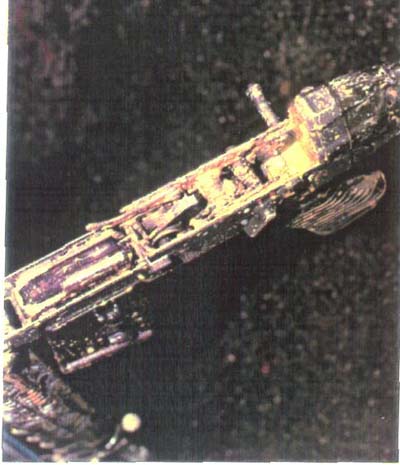
1. Rain trials
- Purpose
The rain trial is a short-term test to determine the effect of heavy rainfall on the function of the weapon. Over a period of 84 minutes, a 12 hour downpour of rain is simulated.
- Procedure
Before beginning the trial the test weapon is lubricated normally. The weapon is to be subjected to the water spray whilst in the armed condition, i.e. ready to fire.
During the trial, the weapon is exposed to a water shower equivalent to approx. 10 mm/min. or 600 +- 76 mm h: The spray is distributed over the entire weapon by means of a device located approx. 1 meter above the weapon.
The sequence of the individual tests is shown in the table marked "Rain Trials".
The test weapons must fulfil the requirements of section I of the table. It is desired that the requirements of section II are also met.
At the end of the firing phase with the muzzle horizontal and then pointing upward, there is a break of 30 minutes during which the weapon shall not be sprayed.
The simulated rainfall value is to be set as listed above and measured. Both air and water temperature are to be recorded. Care must be taken to ensure that the respective air and water temperatures are identical. for all trials.
Firing: 3 series each of 150 rounds single-shot plus 50 rounds fully automatic = total 600 rounds
Requirement: max. 2 malfunctions
Gas valve position 1
Conditions Test Duration Rain Duration
in min total min. in mm total mm I. Weapon Horizontal Bolt open 5 5 51 51 Bolt closed, loaded 5 10 51 102 100 rounds, single shot 4 14 40.6 142.6 Bolt open 5 19 51 193.6 Bolt closed, loaded 5 24 51 244.6 100 rounds, 50 single-sho / fully automatic 10-round strings 4 56 40.6 285.2 II. Weapon with Muzzle Upward Bolt open 5 33 51 336.2 Bolt closed, loaded 5 38 51 387.2 100 rounds, single shot 4 42 40.6 427.8 Bolt open 5 47 51 478.8 Bolt closed, loaded 5 52 51 529.8 100 rounds, 50 single-sho / fully automatic 10-round strings 4 56 40.6 570.4 III. Weapon with Muzzle Downward Bolt open 5 61 51 621.4 Bolt closed, loaded 5 66 51 672.4 100 rounds, single shot 4 70 40.6 713.0 Bolt open 5 75 51 764.0 Bolt closed, loaded 5 80 51 815.0 100 rounds, 50 single-sho / fully automatic 10-round strings 4 84 40.6 855.6
General
Prior to firing the first shot, point the muzzle downward, open the bolt somewhat and allow the water to drain from the barrel.During firing, continue to spray the weapon with water.
- Checking accuracy (after completion of tests)
In order to establish the effect on accuracy that firing under such extreme conditions may have, one additional accuracy firing at 300 m off machine was conducted before and after the verification trials.
- Results
All weapons fulfilled the test requirements in respect of malfunction.
2. Sand and dust trials
The purpose of these trials was to assess the effect of dust and sand on the functional reliability of the weapons.
The composition of the sand and dust mixture, expressed in percentage by weight of particles retained by standard US filters is given below:
|
|||||||||||||||||||||||||||||||||||||||||||||||||||||||
|
- General
- Prior to testing, each weapon fired a sequence of 4 rounds single-shot, 2 x 3-round burst and 10 shots fully automatic to verify that it was in perfect functional order.
- After each test, the weapons were stripped and thoroughly cleaned.
2.1 Stationary sand and dust trials
- Procedure
- Clean and grease each weapon under trial and close off the barrel with a muzzle cap.
- Insert a full 20-round magazine, cycle the weapon and put it on SAFE. If fitted, close the dust cover.
-Firing: 1 x 20-round magazine, single-shot-Requirement: max. 1 malfunction
-Gas valve position 1
The test weapons are to be exposed to the sand and dust follows:
-Place the weapon with its full magazine inserted plus an extra full magazine in the center of the box, in front of the filling hole; ejection port to the bottom of the box. Close the lid of the box.
-Switch on the blower and, within 60 seconds, shake 2.27 kg of the sand and dust mixture mentioned in point 2 through the filling hole
-After 60 seconds, switch off the blower and allow it to run down. Remove the box lid and turn over the weapon and the spare magazine. Close the lid and switch on the blower for another 60 seconds without adding more dust and sand mixture.
-Remove the weapon and the spare magazine from the box and wipe them off with the bare hand only.
-Clean the weapon as best possible by blowing on it with the mouth or by shaking it to remove jammed particles. Remove the muzzle cap.
-Fire the entire inserted magazine in the single-shot mode.
-If this is not possible owing to repeated malfunctions, attempt to fire with the spare magazine.
-If the weapon does not function properly, make a new attempt to fire, using a clean magazine with clean ammunition.
- Results
All weapons completed the trial without malfunctioning.
2.2. Dynamic sand and dust trials
- Purpose
Essentially, this trial is similar to that described under "Sand and dust trials". However, firing takes place while the weapon is exposed to a blown stream of sand and dust.
- Preparations
As described under "Sand and dust trials".
Firing: 100 rounds single-shot and 40 rounds fully automatic = total 140 rounds
Requirement: max. 8 malfunctions
Gas valve position 1

-Procedure
-Clean and lubricate the test weapons; fill seven magazines for each weapon.
-Secure the test weapon in the retention bracket of the sand and dust box. Insert a 20-round magazine and chamber a round. If the weapon is fitted with a dust cover, close this before firing the first shot. Wrap the six other magazines in plastic bags and place them in the box.
-Switch on the blower and then pour in the sand and dust mixture through the filling port at a rate of I kg/min.
- Each weapon which is being exposed to the whirling sand and dust shall now fire 140 rounds in strings of 20. The first 100 rounds are to be fired at 1 shot/sec. and the remaining 40 rounds in short bursts.
-The 20-round strings must be fired within 20 seconds to ensure that the total test time amount to approx. 2 112 minutes.
- Continue firing until a malfunction occurs that cannot be immediately remedied, i.e. if tools or stripping are required, or until all 140 shots have been fired.
-Evaluation
Using a continuous cyclic rate recorder, register total test duration, time up to the first malfunction, time needed to remedy the fault, plus the rate of fire. A vital parameter of this test is the total length of time the bolt is held open in order to rectify a malfunction, change a magazine etc.
-Results
All the test weapons completed the trial without a single malfunction.
2.3. Sand drag trials
-Purpose
The purpose of this test is to assess the effect of sand on the reliable functioning of the weapon by simulating the conditions that a trooper would expect to encounter when crawling along sandy ground.
-Preparations
As previously described under "Sand and dust trials". However, during the entire test, the sand temperature must be + 44'C.
The test weapon is attached to a sled which back and forth along the trough. The sled is designed to ensure that the weapon is constantly guided through the bed of sand in the correct position and at the right depth.
Before beginning the trial, the trough is filled with sand to within 75 mm of its upper edge. The surface of the sand bed must be completely flat. Analysis of the sand is as described under "Sand and dust trials".
-Firing:
- 5 rounds single-shot after each drag test, whereby 20 drag tests 100 rounds
Requirement:
- maximum 4 malfunctions during the first 50 shots (10 drag tests).
- maximum 10 malfunctions during the entire testing cycle (20 drag tests).
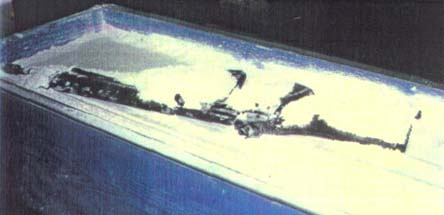
-Procedure- Clean and lubricate the test weapons.
- To establish flawless function of each weapon before testing, first fire a full 20-round magazine. The first half of the magazine in single-shot mode, the remainder in bursts.
-Place the weapon, loaded with 20 rounds. with its left side up (ejection port facing down) onto the surface of the sand. The muzzle is sealed off with a cover and is pointing in the drag direction. The weapon must lie at an angle of 15' to the longitudinal axis of the trough. Press the weapon lightly into the sand by hand. Bring the sled over the weapon and clamp it in the prescribed position.
-The position coordinates of the weapon and the position of the moving parts have a significant affect on the results of the sand drag trial, e.g. bipod removed / stowed / extended.
-Such data must be carefully registered in the test records.
-Using the sled, drag the weapon through the full length of the sand trough at a speed of 0.5 m/sec. i.e. the rate of a creeping or crawling trooper.
-Remove the loaded weapon from the sled. Shake off the loose sand for 5 seconds or blow it off with the mouth. Take off the muzzle cap and fire 5 single shots, with 3 seconds between each shot.
-Turn the safety catch to "SAFE". Replace the muzzle cap and attach the weapon to the sled, this time with the right side facing upward.
-Carry out a total of 20 drag tests, i.e. 10 with the left side up and 10 with the right side up. Tests should be stopped if a situation occurs whereby the bolt does not close upon cycling or after manual assistance. If weapon cycling or manual assistance is required three times in a row, the test sequence should also be stopped.
-If malfunctions occur which cannot be rectified by cycling the weapon or by manual assistance on the bolt, proceed as follows:
- Unload the weapon, i.e. remove the magazine, cock the weapon and pull the trigger. Repeat this operation three times. Now reload the weapon and continue the trial.
- If a magazine becomes empty from firing or loss of rounds because of malfunctions or cycling, replace it with a clean full one. Chamber a round and continue testing.
-Results
All test weapons met the trial requirements (gas valve position 2).
2.4. Mud trials
-Purpose
The purpose of the mud trails is to determine the limits of functional reliability of the test weapon after it has been submerged in 12 consecutive mud baths, each of which is increasingly thicker than the one before.-Preparation
Clean, lubricate and prepare each test weapon for firing.
-Firing: 4 rounds single-shot; 2 x 3-round bursts and 10 fully automatic = total 20 rounds
-Requirements: (mandatory baths)- Bath 2 + 7 : max. 1 malfunction
- Bath 3 + 8 : max. 3 malfunctions
- Bath 4 + 9 : max. 6 malfunctions
Total max. 10 malfunctions
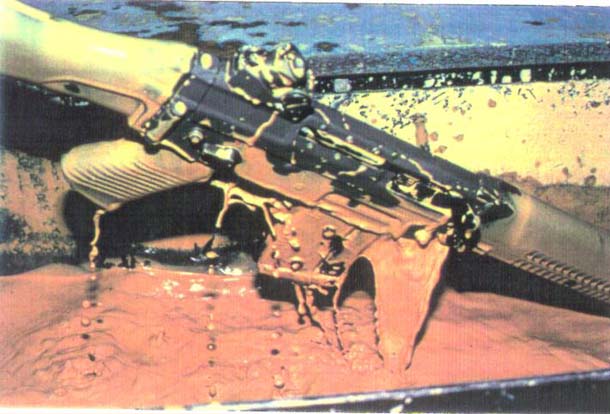
-Procedure
Testing is to be conducted as follows:
a)
Prepare the weapons for the mud bath trials in the same manner as for the stationary sand and dust trials. Submerge the loaded and SAFE weapon in the mud bath and move it back and forth for 60 seconds.
Now fire the test weapon in the following sequence until the magazine is empty:
Single-shot : 4 rounds every 3 seconds
Bursts : 2 x 3 rounds
Fully automatic: 10 roundsThe time taken between removing the weapon from the mud bath and the firing sequence shall be as short as possible and not more than 60 seconds.
b)
Each test weapon is to be submerged in 12 consecutive mud baths of varying viscosity.
The consecutive sand and mud baths have the following composition:
|
|
|
||
|
|
|
|
|
|
|
|
|
|
|
|
|
|
|
|
|
|
|
|
|
|
|
|
|
|
|
|
|
|
|
|
|
|
|
|
|
|
|
|
|
|
|
|
|
|
|
|
|
|
|
|
|
|
|
|
|
|
|
|
|
|
|
|
|
|
|
|
|
|
Before submerging the weapon in the respective mud bath, thoroughly clean it and prepare it for firing in the same manner as for the sand and dust trials.
c)
The clay used in the trials shall be free of sand and sourced from the lower strata of the ground. The quartz sand employed must be clean and dry and pass 100 % through US standard sieve no.16; 80 % through US standard sieve no.30 and 3.5 % through US standard sieve none.
d)
Terminate testing as soon as the weapon does not function flawlessly after submersion in one of the baths. Use magazines in the following sequence:
- Magazine inserted in the weapon
- Magazine separately submitted to mud bath treatment
- Clean magazine
-Results-General:
All weapons fulfilled the test requirement of max. 10 permissible malfunctions.
-Observation:
These extreme trials indicated that the majority of malfunctions could be attributed to the magazines, e.g.
- jammed column of ammunition (bolt closes on an empty chamber)
- rounds rise too slowly (failure to strip and chamber new round)
- stripping resistance is too great (bolt does not close fully)
Weapon function is affected primarily by the degree of magazine fouling.
In view of the magazine malfunctions, a clean magazine was inserted after each dipping in baths no.10 onwards. Gas valve position 2 was also selected.
-Result:
Functioning in order.
2.5. Testing under extreme temperatures
2.5-1. High temperature testing
- Purpose
The purpose of this test was to assess the effect of extreme heat on the normal function, ruggedness and lubrication of the weapon.
- Procedure
Expose each weapon together, with at least 600 rounds of ammunition, in magazines to a temperature of + 600C at an ambient humidity level below 5 % for at least 12 hours. Then, from the temperature chamber, fire 12 strings of 50 shots. Wait for at least 2 hours between strings so that the weapon can cool down to + 600C again.
The 50-round strings are to be fired in the following sequence:
10 rounds single-shot
20 rounds in 3-shot bursts
20 rounds fully automaticAfter each 100 rounds, field type lubrication is permitted.
2.5.2. Low temperature testing
- Purpose
The purpose of this test is to assess the effect of extreme cold on the normal function, ruggedness and lubrication of the weapon.
- Procedure
Expose each weapon, together with at least 600 rounds of ammunition in magazines, to a temperature of - 300C for 12 hours. Then from the cold storage chamber, held at - 30'C, fire 12 strings of 50 shots. Wait for at least 2 hours at 30'C between strings of 50 rounds to ensure that the weapon can cool down.
The 50-round strings are to be fired in the following sequence:
10 rounds single-shot
20 rounds in 3-shot bursts
20 rounds fully automatic
-Results
All test weapons fulfilled the requirements of both trials: functional reliability is guaranteed.
2.5.3. Icing-up tests
-Purpose
The purpose of this trial is to establish whether the weapon remains functional in spite of different thicknesses of ice layers as a result of freezing rain.
-Procedure, test no. 1
Prepare the weapon for icing-up.
- Clean and lubricate the test weapons.
- Assemble the weapon and seal off the barrel with a muzzle cap. Insert 1 loaded magazine, chamber a round and put on SAFE.
Expose the weapon and 40 rounds in 2 magazines to a temperature of - 100C for 6 hours. Support the weapon on its bipod and then spray it lightly with water until a layer of ice at least 3 mm thick has formed on the surface.
Firing
Remove the muzzle cap. Scrape the ice off the weapon and ammunition using only the implements the trooper normally has available (pocket knife, bayonet).
2 x 20 rounds: 5 single-shot; 2 x 3-round bursts; remainder fully automatic.
-Procedure, test no. 2
Prepare the weapon for icing-up.
- Clean and lubricate the test weapons. Assemble each weapon, chamber a round and put on SAFE.
The magazine now contains 19 rounds.
- Incline the weapon at an angle of 450 with the muzzle pointing down. At a temperature of min. + 2' C lightly spray the weapon with water for 15 minutes.
Then shake the weapon for 1 minute to remove water from the barrel. Cool each test weapon for 2 hours at - 10' C. Subsequently, fire 20 rounds from each weapon in the following sequence:
5 rounds single-shot
2 x 3-round bursts
Remainder fully automatic-Each test is to be repeated twice.
-Results:
Function in order - trials concluded without a single malfunction.
2.5.4. Cold tests
Jungfrau Joch (Elev. 3475 meters)
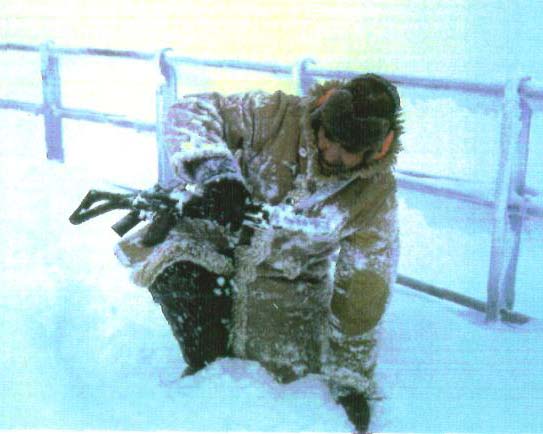

2.6. Functional reliability of unlubricated weapons
- Purpose
The purpose of this test is to assess the performance of the weapon in the unlubricated condition.
-Procedure
Degrease the weapon with a non-oily solution and dry it well. Assemble the weapon in the unlubricated condition.
A total of 500 rounds are to be fired from each test weapon. observing the following sequence:
20 rounds single-shot, one shot every 5 seconds.
20 rounds in 3-shot bursts, with 10 seconds pause between bursts.
20 rounds fully automatic fire.Once the weapon has cooled down, repeat the sequence until 8 strings have been fired. After these 480 rounds the remaining 20 shall be fired rapidly in the singleshot mode.
- Measurement of cyclic rate
The time taken to fire the 20 rounds in the fully automatic mode shall be registered by a cyclic rate recorder and subsequently evaluated.
-Malfunction
In case of a malfunction, while operating the weapon with gas valve on position 2. locate the area, the position or the part responsible for the malfunction, punctually greasing them, to guarantee again a proper function.
-Results
All weapons fulfilled the test requirements.
2.7. Plastic magazines: Drop tests
- Purpose
To assess the function of the magazine after the drop onto a stony surface.
-Procedure
-A filled magazine is dropped from a height of 1.50 meter onto a concrete surface, as follows:
a) 7 times on any given side of the magazine
b) 3 times with magazine lip head-on.- Firing of the magazine in single-shot and fully automatic.
(The drop tests will be conducted during temperatures of + 200C and - 20' C).
-Requirements
- During fire of the tested magazines, no malfunction are allowed.
- No deformation or defects, which short-dated, could influence the function of the magazines.
III. Quality Inspections / Acceptance
1. Quality Assurance
The products fulfil in all respects the requirements and test specifications listed in extract form below.
The quality assurance criteria are based on the NATO specification level Al (or in accordance with AQAP 1).
1.1 Quality assurance programme (extracts)
- Execution, surface and heat treatment
Verification of conformity to drawings of components and assembly, plus their surface and heat treatment.
- Heavy duty components
Are to be subjected to hardness and destructive testing (case hardening layer and microstructure).
- Critical components
From current manufacture must be subjected to suitable destructive testing in order to monitor heat treatment cycles, case hardening depth and material microstructure.
- Springs
Shall be tested for dimensional integrity, spring force cycles (PX) and behaviour by endurance testing.
-WeldingWelding is to be conducted in a manner which provides welds with low residual stress, radiographic integrity and absence of inclusions and cracking. Minor gas impressions are permissible. The requirements of DIN 1910 apply
-Barrels
Barrels are to be inspected for straightness by a suitable process (e.g. light and shadow process).
- In order to ensure barrel manufacturing quality (e.g. caliber, groove depth and width, chamber) solid gauges are to be used in addition to the variable (dimensional) test methods.
-Testing of functions (all weapons)
The complete weapon shall be inspected and tested to verify correct assembly, settings and general functioning.
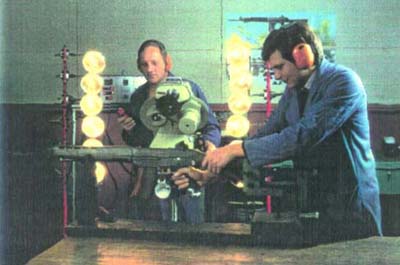
-Dimensional checks on assembled and Partially assembled weapons (all weapons)Check the bolt lock-up gap (headspace) with calibrated guage rounds plus trigger pull weight after proof-firing.
- Overpressure proofing (all weapons)
Each weapon shall be subjected to overpressure testing by firing two proofing cartridges.
- Zeroing the weapons (all weapons)
- Zeroing is to be conducted by the responsible department of the manufacturer.
- The above mentioned firing tests are an integral part of the comprehensive firing programme (in accordance with separate programme).
Accuracy Trial
with
various makes of ammunition-Range 300m
-Averge values out of 3 groupings each at 24 rounds
-Weapon: SIG SG550
Ammunition Points Scored 5.6mm GP 90 236 FN SS109 223 INDEP SS109 228 Jugoslawien SS109 217 Hirtenberger SC 225 FN SS92 221 INDEP 230 DAG 220 ALM 222 SMI 225 IMI Samson 227 Phillippinen 225 Korea 224 China 226 Winchester 219 Federal 223 Brazillian 222
IV. Interchangeability of components and sub-assemblies
(Please click on image below for much larger version of this diagram)
List of Parts Assault Rifle SG 550/551
6. Appendix
6.1. List of parts
|
|
|
|
|
100 Receiver
|
200
Barrel / gas system 211 Barrel* 212 Front sight mount* 213 Roll pin 214 Spring ring** 221 Bayonet lug** 222 Spring pin** 223 Stop pin 224 Compression spring 225 Spring pin 231 Front sight 232 Night front sight 233 Positioning bolt 234 Night front sight spring 235 Spring pin 236 Front sight screw* 237 Front sight disc* 238 Spring pin 241 Gas valve 251 Gas tube 261 Gas piston 262 Recoil spring 263 Spring pin 264 Spring pin 265 Spacer 268 Support washer |
300 Handguard
|
400s 500s 600s 400 Bolt
411 Bolt head
412 Firing pin
413 Firing pin stud
414 Firing pin spring
415 Extractor
416 Extractor spring
417 Pin
421 Bolt carrier
422 Bolt handle catch
423 Axle of bolt handle catch
424 Spring of bolt handle catch
425 Bolt handle
500 Trigger assembly
501 Trigger casing
510 3-round burst facility
511 Template
512 Chargeover
513 Pawl
514 Pawl spring
515 Bush
516 Segment
517 Segment axle
518 Segment spring
519 Locking washer
520 Compression spring
521 magazine catch
522 Magazine catch spring
523 Magazine catch pin
524 Bush
531 Release bar
532 Circlip
541 Pistol grip
542 Floorplate
543 Allen screw
544 Stop nut
545 Nameplate
551 Pressure point screw
552 Stop nut
553 Pressure point spring
554 Trigger guard
555 Trigger guard bearing
561 Hammer
562 Hammer axle
563 Main spring
564 Bolt catch
565 Bolt catch spring
566 Spring bolt
571 Safety lever
572 Safety shaft
573 Locking spring
575 Autom. firing lock axle
576 spring pin
578 Stop ring
581 Trigger
582 Trigger spring
583 Trigger rod
584 Pivot trigger
585 Trigger bush
586 Trigger rod spring
587 Sear*
588 Automatic fire pawl
589 Automatic fire pawl spring
591 Trigger casing stud
592 Spring-pressure pin
593 Spring for trigger casing stud
594 Spring pin
595 Pin
596 Cup spring
597 Baffle plate
598 Sear bolt*
599 Sear roller*600 Butt
611 Buttstock
612 Butt catch
613 Butt catch spring
614 Clip
615 spring pin
616 Butt plate
700s 700 Magazine
711 magazine casing
712 Magazine floorplate
713 Floorplate catch
714 Feeder
715 Magazine spring
** Not on SG 551
* Cannot be ordered as individual parts
Last Modified
on May 9, 1999
aalbert@biggerhammer.net